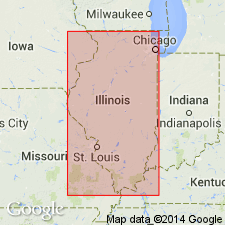
- Usage in publication:
-
- Tyson Member
- Modifications:
-
- Original reference
- Dominant lithology:
-
- Limestone
- AAPG geologic province:
-
- Illinois basin
- Lincoln anticline
Summary:
Pg. 111, 235. Tyson Member of Kings Lake Formation of Decorah subgroup [informal] of Galena Group. Consists largely of dolomitic, very silty, and argillaceous limestone. Commonly medium- to thick-bedded. Thickness 7.5 feet at type section; thins northward to 4.25 feet at Kings Lake, Missouri, and 3 feet 11 inches at New London, Missouri. Overlies Mincke Member (new). Underlies Dunleith Formation: in some areas the Guttenberg truncates the Dunleith and rests directly on the Tyson. Age is Middle Ordovician (Champlainian).
Type section: exposure in south bluff of Meramec River along St. Louis-San Francisco RR, 0.25 mi northeast of Mincke Siding, near center E/2 SE/4 SE/4 sec. 21, T. 44 N., R. 4 E., Manchester 7.5-min quadrangle, St. Louis Co., eastern MO. Named from Tyson Hollow, a small branch of Meramec Valley, St. Louis Co., eastern MO.
["Subgroup" not recognized as a formal stratigraphic rank term (CSN, 1933; ACSN, 1961, 1970; NACSN, 1983, 2005, 2021). Considered informal and should not be capitalized.]
Source: US geologic names lexicon (USGS Bull. 1350, p. 788).
For more information, please contact Nancy Stamm, Geologic Names Committee Secretary.
Asterisk (*) indicates published by U.S. Geological Survey authors.
"No current usage" (†) implies that a name has been abandoned or has fallen into disuse. Former usage and, if known, replacement name given in parentheses ( ).
Slash (/) indicates name conflicts with nomenclatural guidelines (CSN, 1933; ACSN, 1961, 1970; NACSN, 1983, 2005, 2021). May be explained within brackets ([ ]).

